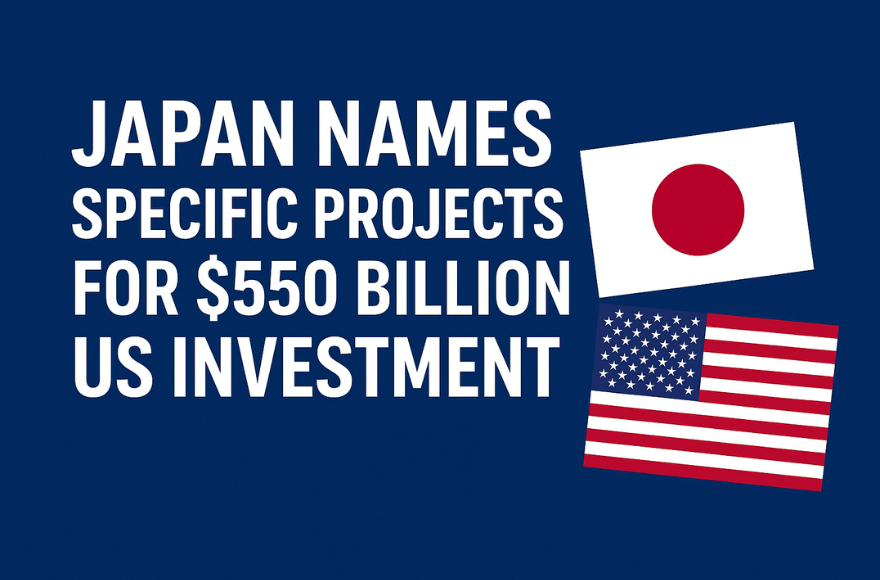
Japan has recently announced specific projects under its massive Japan US $550 billion investment deal, marking one of the most ambitious collaborations between the two nations. This partnership highlights Japan’s growing role in supporting American industries like semiconductors, clean energy, infrastructure, and advanced manufacturing. It’s not just a trade agreement — it’s a long-term vision for shared prosperity, technological growth, and global stability.
The Japan $550 billion investment projects USA plan was officially detailed during the latest US-Japan Economic Dialogue. This initiative aims to promote mutual economic growth while focusing on strategic industries critical for both nations’ security and sustainability.
Through this massive financial commitment, Japan plans to strengthen its presence in key sectors such as energy, critical minerals, shipbuilding, and technology innovation. The Japanese government and major corporations, along with the Japan Bank for International Cooperation (JBIC), are taking the lead in executing this ambitious agenda.
The US-Japan trade deal $550 billion sectors includes several crucial areas where both countries are aiming to deepen collaboration. These sectors represent future-focused industries that drive innovation and economic stability.
Semiconductors and Electronics: Japan will expand its investment in US-based chip manufacturing to reduce global supply chain risks.
Clean and Renewable Energy: Japan is investing heavily in wind, solar, and hydrogen energy projects across the United States.
Infrastructure Development: The plan includes modernizing transport systems, smart cities, and port facilities.
Critical Minerals and Shipbuilding: Japan’s involvement ensures a sustainable supply of materials and the revival of maritime industries.
By targeting these areas, both nations aim to secure economic resilience and technological self-reliance.
One of the most strategic aspects of the deal is Japan investment in US semiconductors and energy. Japan is channeling billions into semiconductor facilities across states like Arizona and Texas, partnering with US firms to produce advanced microchips needed for AI, defense, and communication technologies.
In energy, Japanese companies are working with American partners to build clean-hydrogen plants, offshore wind farms, and carbon-capture projects. This move aligns with both countries’ commitment to achieving net-zero emissions by 2050.
The Japan US investment facility JBIC $550 bn is a major driving force behind this initiative. JBIC will provide financial assistance, low-interest loans, and strategic partnerships to ensure smooth project execution.
This facility is designed to help Japanese and American businesses collaborate on high-impact projects, particularly in renewable energy and advanced manufacturing. It’s a step toward a future where public-private partnerships create sustainable, long-term value.
The new US-Japan tariff deal and Japanese investment component simplifies trade policies between the two countries. Both governments are working to lower tariffs on critical imports and exports, promoting smoother business operations and encouraging more cross-border collaboration.
For American industries, it means easier access to Japanese technology and capital. For Japan, it ensures access to US markets, innovation ecosystems, and energy resources — a true win-win arrangement.
Under this plan, Japan invests in US energy infrastructure $550 bn, focusing on modernizing power grids, building smart energy networks, and supporting electric vehicle (EV) infrastructure.
These projects are not just about profits; they aim to strengthen America’s green economy while allowing Japanese companies to expand globally in clean-tech and renewable energy solutions.
The initiative also prioritizes Japan invests in US critical minerals and shipbuilding. Japan recognizes that critical minerals like lithium, nickel, and rare earth elements are essential for EVs, defense technologies, and electronics. By investing in the US mining sector, Japan ensures a secure and sustainable supply chain.
Additionally, the partnership aims to revive US shipyards through joint ventures and technology sharing, ensuring both countries maintain strong maritime capabilities.
The Japan US strategic industries investment 2025 vision sets the foundation for future-oriented collaboration. Both nations are focusing on emerging fields such as robotics, quantum computing, biotechnology, and artificial intelligence.
These investments will help build resilient supply chains and enhance economic security amid global uncertainties. The 2025 plan also emphasizes workforce training, skill development, and innovation hubs in both countries.
To streamline all these efforts, Japan launches facility to support US $550 billion investment — a comprehensive framework that connects Japanese investors with American businesses and state governments. This facility ensures transparency, coordination, and faster approval processes for upcoming projects.
The move demonstrates Japan’s strong confidence in the US economy and its long-term commitment to strengthening bilateral relations.
The Japan US $550 billion investment deal marks a historic milestone in global economics. It’s more than just numbers — it’s a symbol of trust, shared vision, and cooperation between two of the world’s strongest economies.
From semiconductors and renewable energy to infrastructure and advanced technologies, this collaboration sets the stage for sustainable development and innovation.
As Japan $550 billion investment projects USA unfold over the coming years, we can expect significant advancements in green energy, digital technology, and global supply-chain resilience. This initiative isn’t just about investing in industries — it’s about investing in the future of global progress.

 Next
Next
Comments (0)
Leave a comment